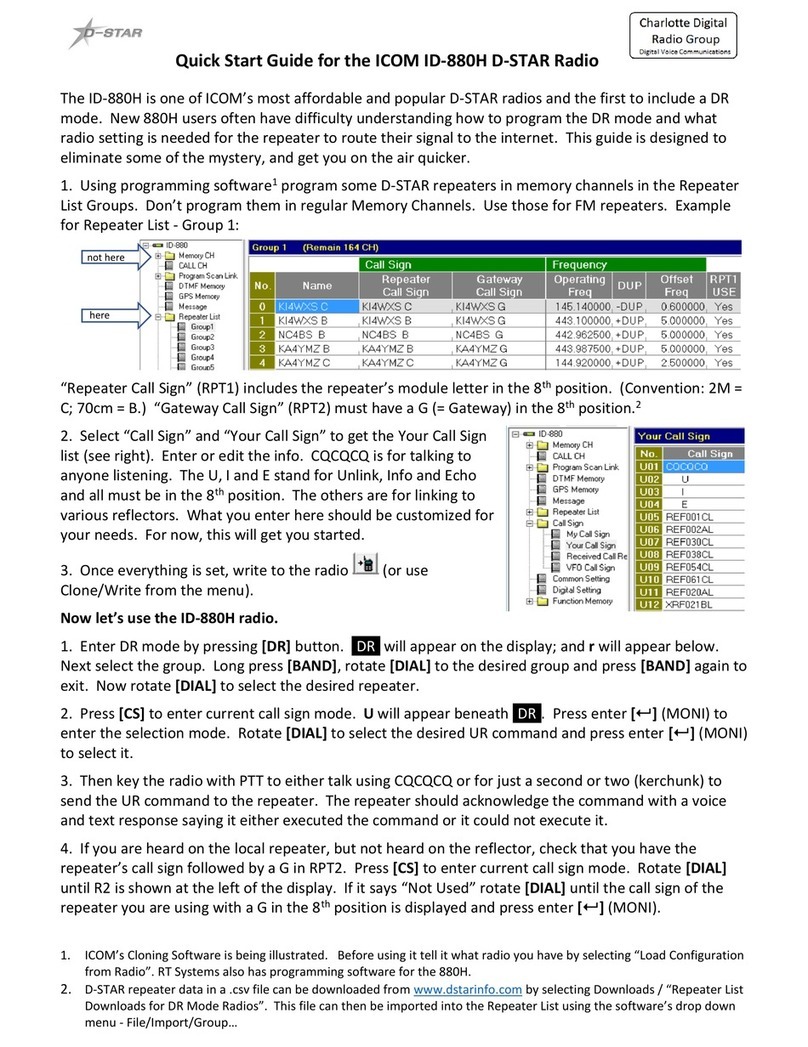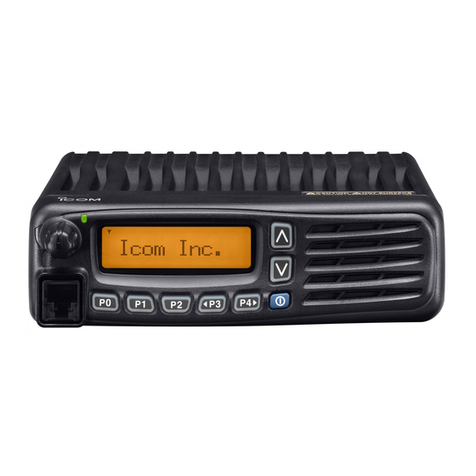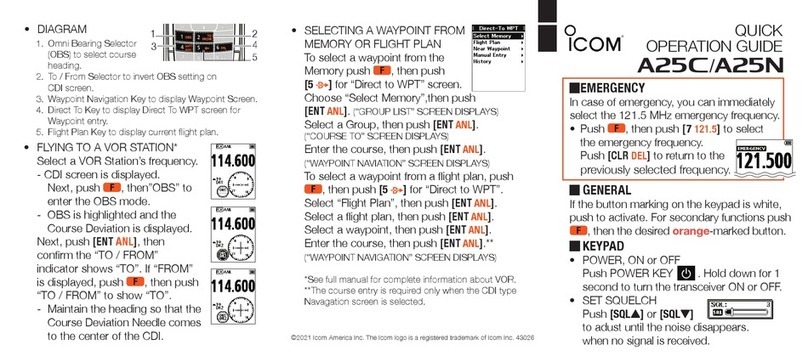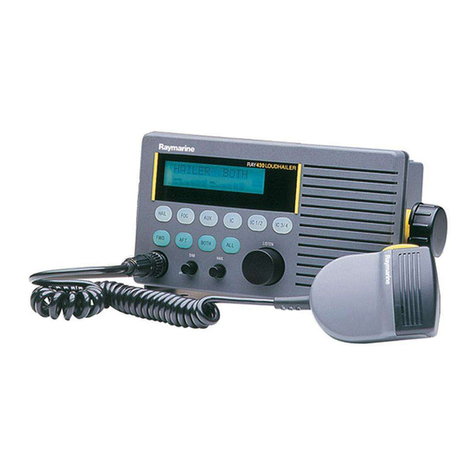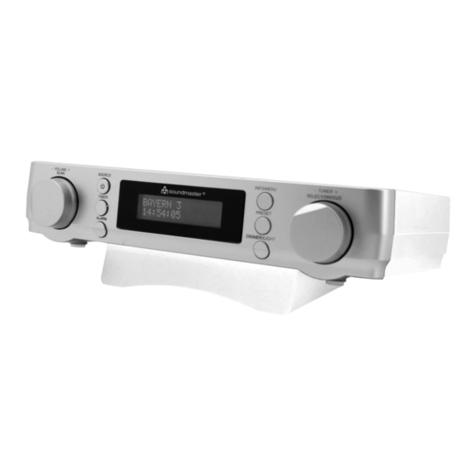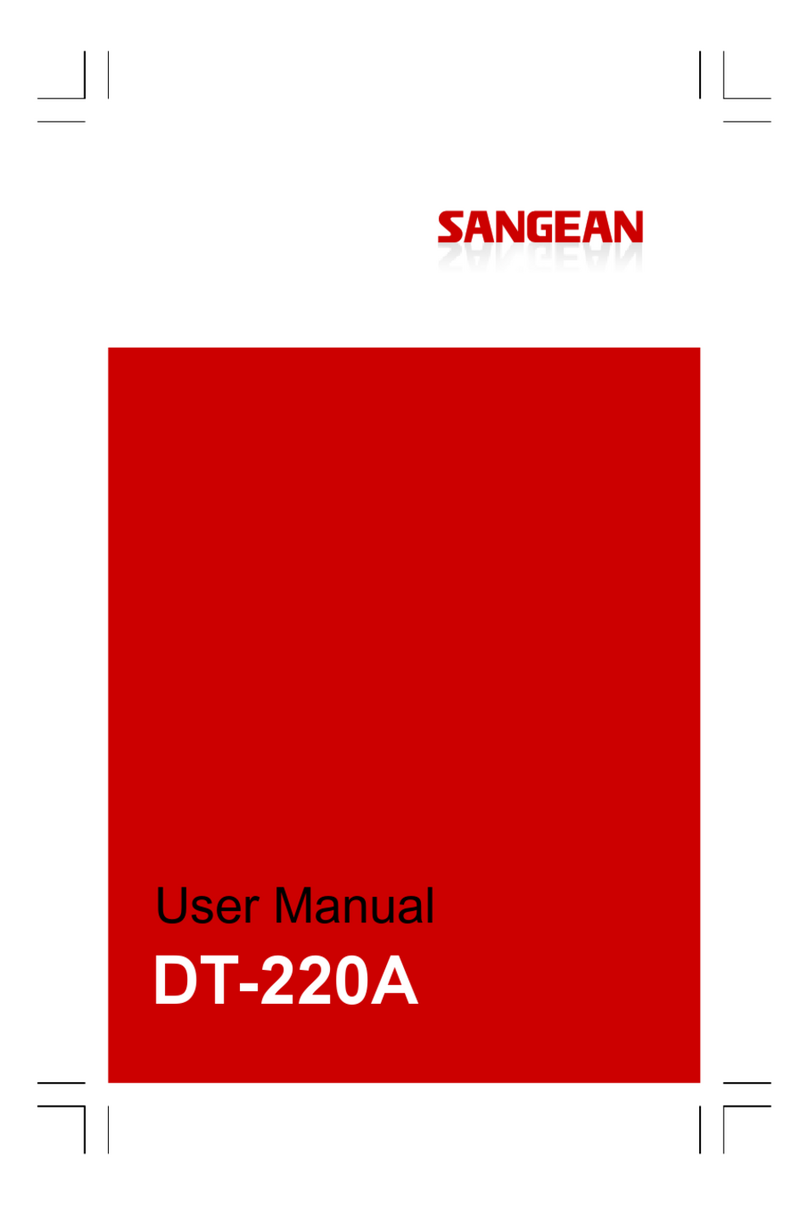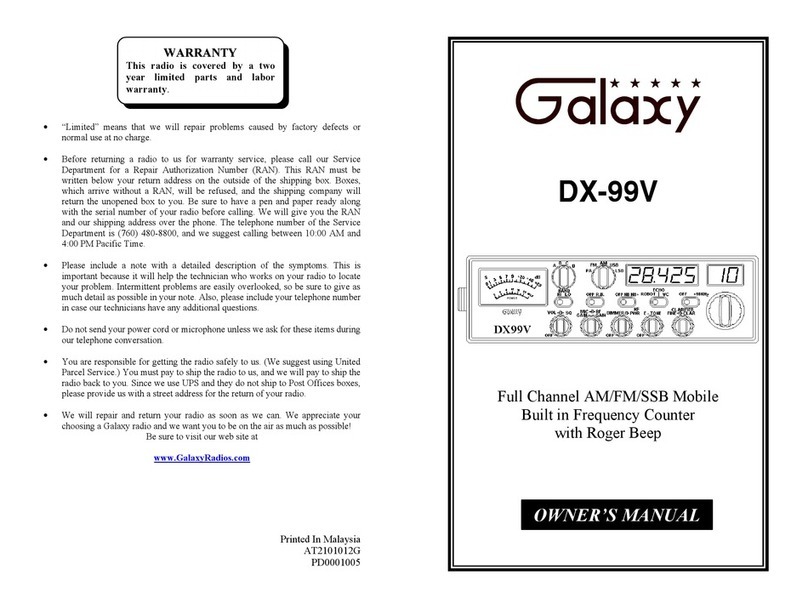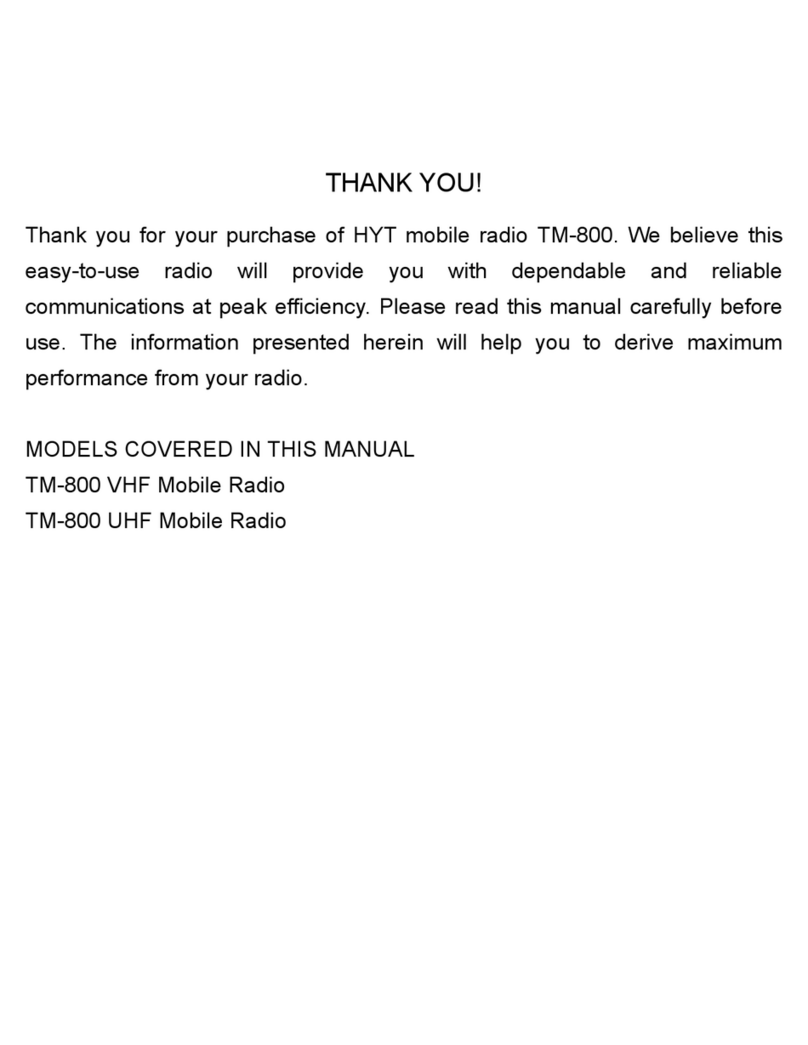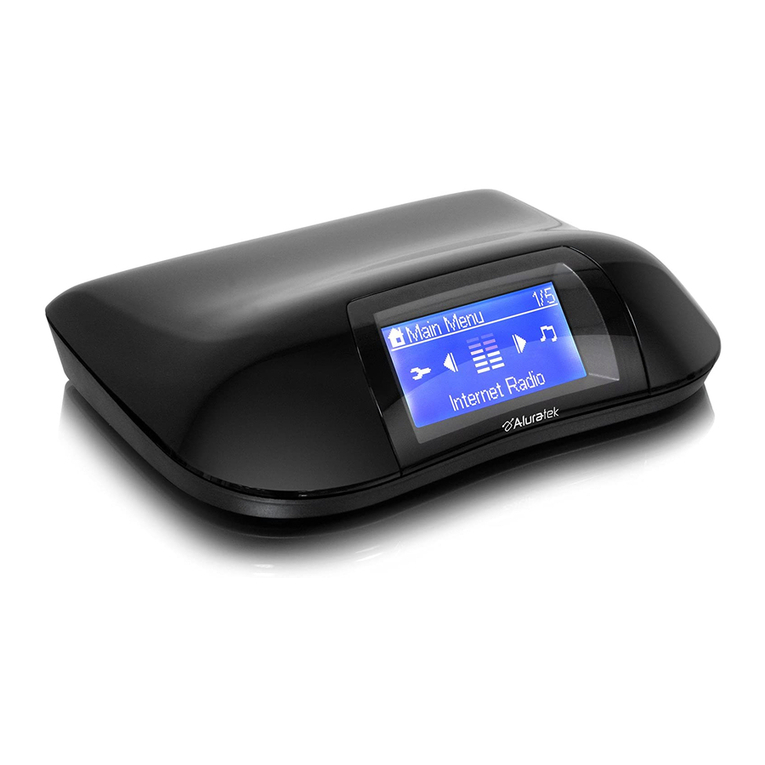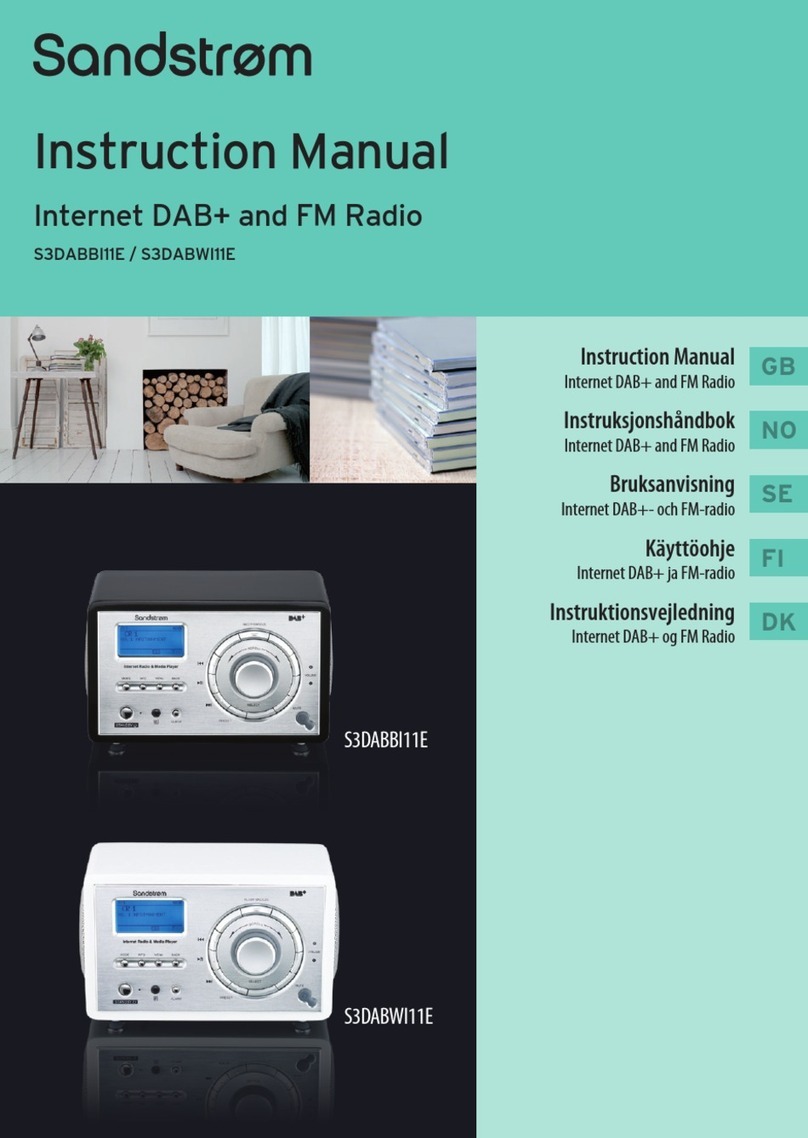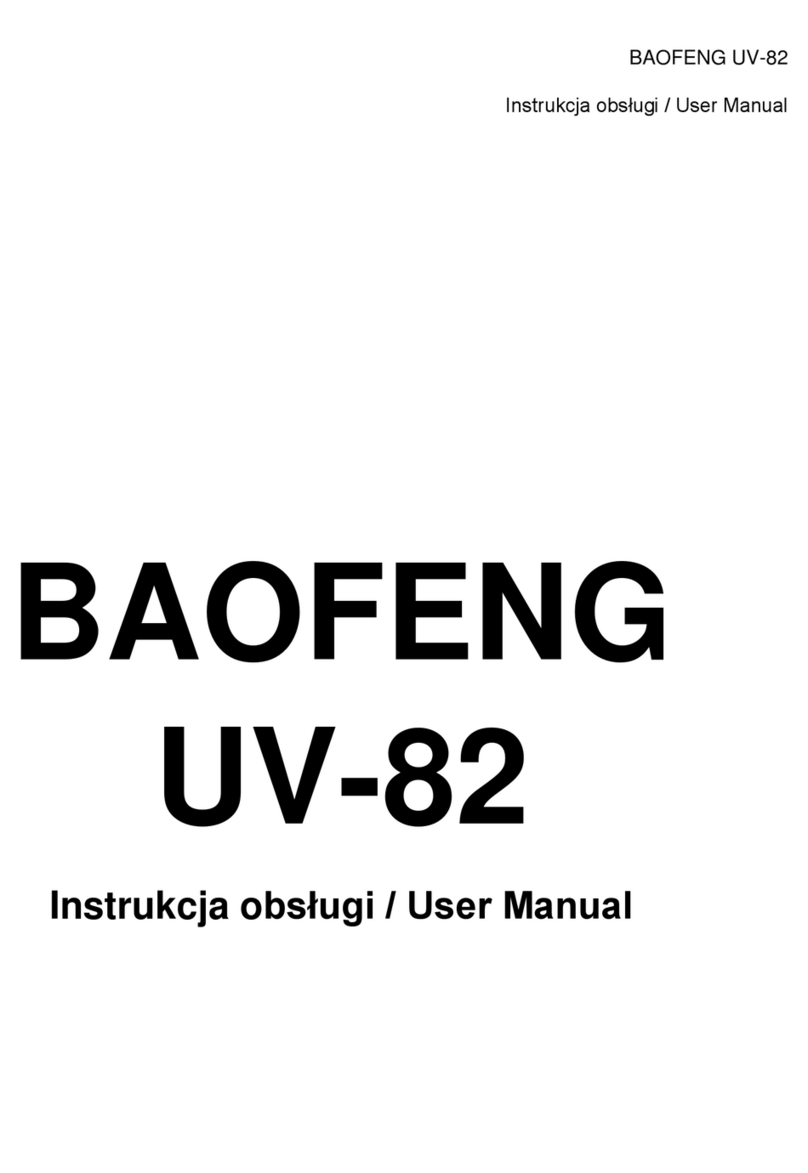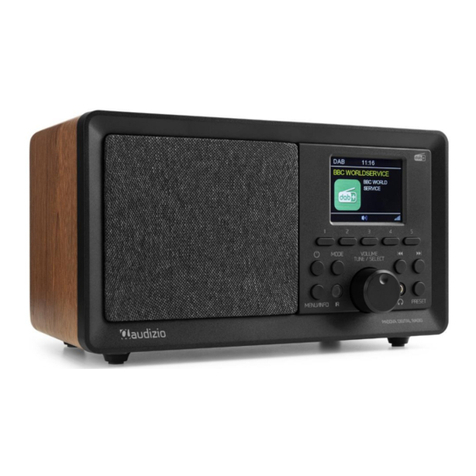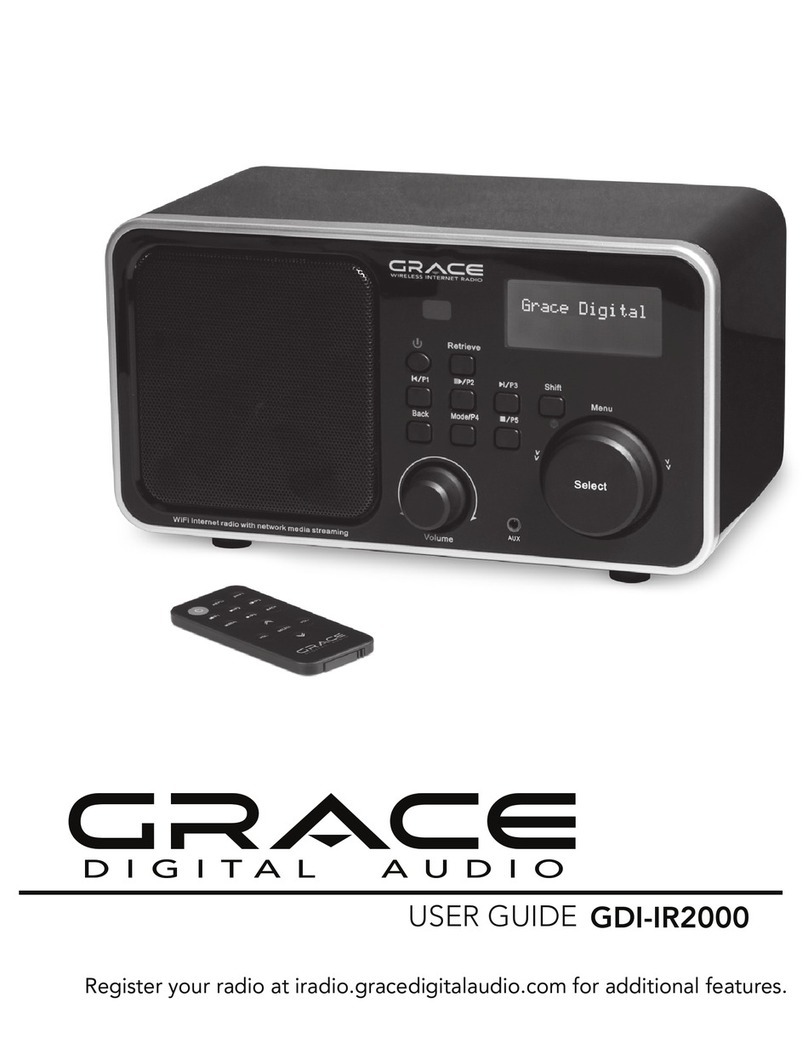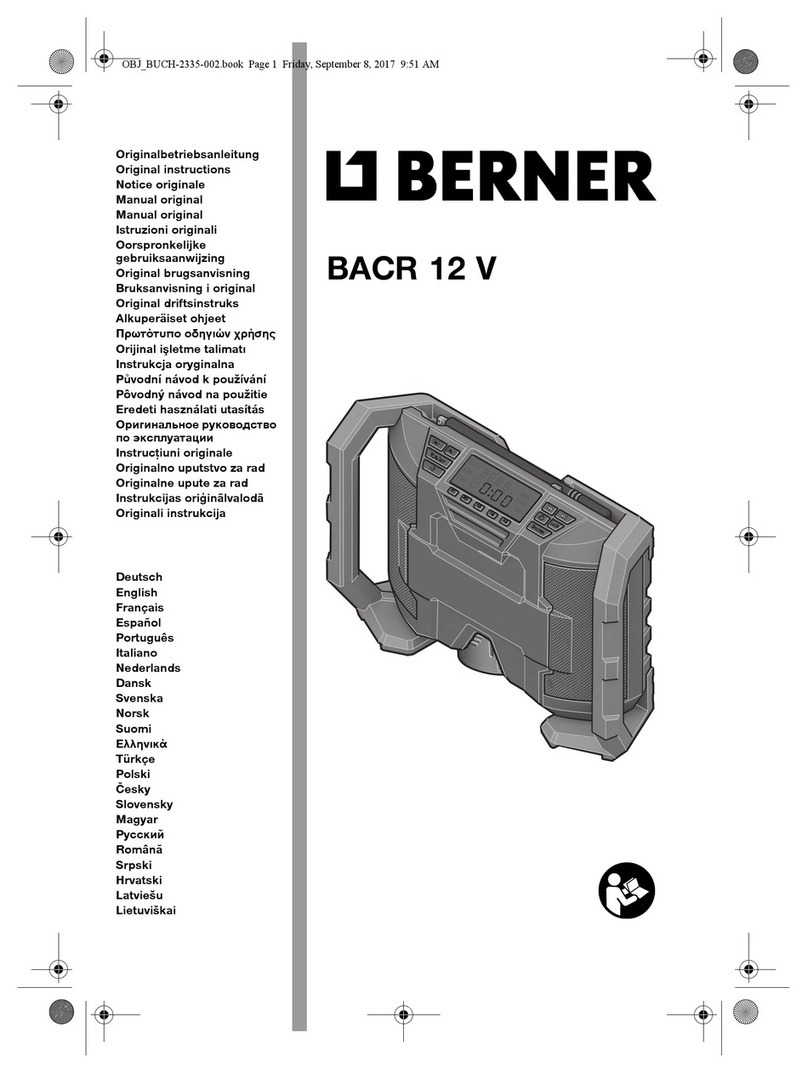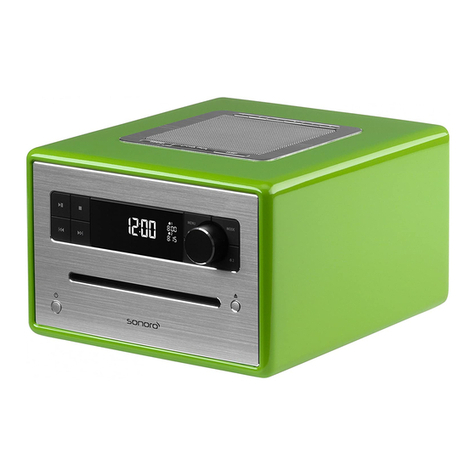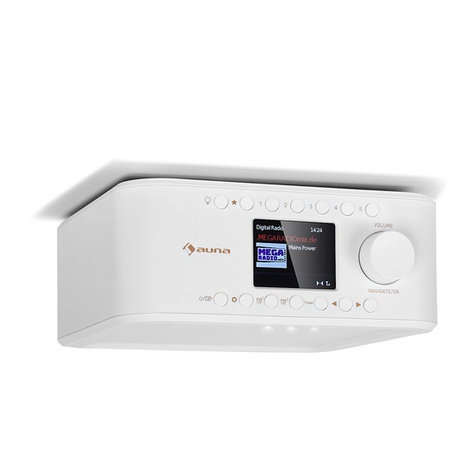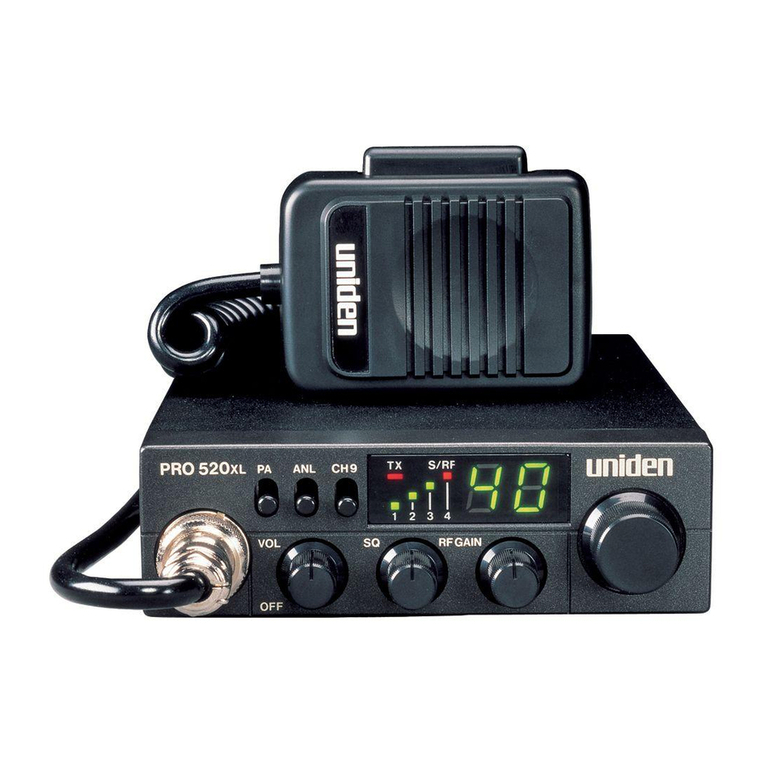Icom iF610 User manual

iF620
UHF TRUNKED RADIO
INSTRUCTION MANUAL
iF610
IC-F610_F620_MPT_1.qxd 05.8.22 6:07 PM Page A (1,1)

Your Icom radio generates RF electromag-
netic energy during transmit mode. This
radio is designed for and classified as
“Occupational Use Only”, meaning it must
be used only during the course of employ-
ment by individuals aware of the hazards,
and the ways to minimize such hazards. This radio is
NOT intended for use by the “General Population” in an
uncontrolled environment.
• For compliance with FCC and Industry Canada RF
Exposure Requirements, the transmitter antenna installation
shall comply with the following two conditions:
• The transmitter antenna gain shall not exceed 0 dBi.
• IC-F620:
The transmitter antenna is required to be located outside
of a vehicle and kept at a separation distance of 37 cen-
timeters or more between the transmitter antenna of this
device and persons during operation.
To ensure that your exposure to RF elec-
tromagnetic energy is within the FCC
allowable limits for occupational use,
always adhere to the following guidelines:
•DO NOT operate the radio without a proper antenna
attached, as this may damage the radio and may also cause
you to exceed FCC RF exposure limits. A proper antenna is
the antenna supplied with this radio by the manufacturer or
an antenna specifically authorized by the manufacturer for
use with this radio.
•DO NOT transmit for more than 50% of total radio use time
(
“
50% duty cycle”). Transmitting more than 50% of the time
can cause FCC RF exposure compliance requirements to
be exceeded. The radio is transmitting when the “TX indica-
tor” lights red. You can cause the radio to transmit by push
the “PTT” switch.
Electromagnetic Interference/Compatibility
During transmissions, your Icom radio generates RF energy
that can possibly cause interference with other devices or
systems. To avoid such interference, turn off the radio in
areas where signs are posted to do so. DO NOT operate the
transmitter in areas that are sensitive to electromagnetic radi-
ation such as hospitals, aircraft, and blasting sites.
SAFETY TRAINING INFORMATION
WARNING
CAUTION
IC-F610_F620_MPT_1.qxd 05.8.22 6:07 PM Page B (1,1)

i
EXPLICIT DEFINITIONS
WORD DEFINITION
WARNING Personal injury, fire hazard or electric shock
may occur.
CAUTION Equipment damage may occur.
NOTE If disregarded, inconvenience only. No risk
of personal injury, fire or electric shock.
READ ALL INSTRUCTIONS carefully and com-
pletely before using the transceiver.
SAVE THIS INSTRUCTION MANUAL —This
instruction manual contains important operating instructions
for the IC-F610/IC-F620 UHF TRUNKED RADIO.
IMPORTANT
Icom, Icom Inc. and the logo are registered trademarks of Icom
Incorporated (Japan) in the United states, the United Kingdom,
Germany, France, Spain, Russia and/or other countries.
Thank you for purchasing this Icom product. The IC-F610/
F620 UHF TRUNKED RADIOs are designed and built with
Icom’s superior technology and craftsmanship. With proper
care, this product should provide you with years of trouble-
free operation.
We want to take a couple of moments of your time to thank
you for making your IC-F610/F620 your radio of choice, and
hope you agree with Icom’s philosophy of “technology first.”
Many hours of research and development went into the de-
sign of your IC-F610/F620.
ïï
FEATURES
❍
Compatible with MPT 1327/1343 Networks
❍
Short Data Message (SDM)
❍
32 Status Messages Capability
❍
MAP27 Data Communication Protocol, RS-
232C PC Interface
❍
Optional Voice Scrambler Unit, UT-109/UT-110
❍
Flash ROM CPU, Firmware Upgrade Capabil-
ity
❍
Keypad microphone (HM-152T) Available
FOREWORD
IC-F610_F620_MPT_1.qxd 05.8.22 6:07 PM Page i (1,1)

ii
WARNING! NEVER connect the transceiver to an
AC outlet. This may pose a fire hazard or result in an electric
shock.
NEVER connect the transceiver to a power source of
more than 16 V DC such as a 24 V battery. This connection
will ruin the transceiver.
NEVER cut the DC power cable between the DC plug
and fuse holder. If an incorrect connection is made after cut-
ting, the transceiver might be damaged.
NEVER place the transceiver where normal operation
of the vehicle may be hindered or where it could cause bodi-
ly injury.
NEVER allow children to touch the transceiver.
NEVER expose the transceiver to rain, snow or any liq-
uids.
USE supplied microphone only. Other microphones have
different pin assignments and may damage the transceiver.
DO NOT use or place the transceiver in areas with tem-
peratures below –22°F (–30°C) or above +140°F (+60°C) or,
in areas subject to direct sunlight, such as the dashboard.
AVOID operating the transceiver without running the vehi-
cle’s engine. The vehicle’s battery will quickly run out if the
transceiver is in transmission while the vehicle’s engine OFF.
AVOID placing the transceiver in excessively dusty envi-
ronments.
AVOID placing the transceiver against walls. This will
obstruct heat dissipation.
AVOID the use of chemical agents such as benzine or
alcohol when cleaning, as they damage the transceiver sur-
faces.
BE CAREFUL! The transceiver will become hot when
operating continuously for long periods.
For U.S.A. only
CAUTION: Changes or modifications to this transceiver, not
expressly approved by Icom Inc., could void your authority to
operate this transceiver under FCC regulations.
PRECAUTION
IC-F610_F620_MPT_1.qxd 05.8.22 6:07 PM Page ii (1,1)

iii
SAFETY TRAINING INFORMATION
FOREWORD ……………………………………… i
IMPORTANT ……………………………………… i
EXPLICIT DEFINITIONS ………………………… i
PRECAUTION …………………………………… ii
TABLE OF CONTENTS ………………………… iii
1 PANEL DESCRIPTION …………………… 1–4
■Front panel ………………………………… 1
■Programmable key assignment …………… 3
■Function display …………………………… 4
2 OPERATION ……………………………… 5–12
■Turning power ON ………………………… 5
■General ……………………………………… 5
DOpening text ………………………………… 5
■Calling ……………………………………… 6
DMaking a call with a Memory Dial Number 6
DMaking a call with a Memory Individual Code 7
DCalling the Despatcher……………………… 7
DMaking a Status Call………………………… 8
DSending a status message to the Despatcher 8
DInclude Call ………………………………… 9
DPTT Quick Call function …………………… 9
■Making a call via the keypad ……………… 9
DIndividual Call ……………………………… 9
DGroup Call ………………………………… 10
DStatus Call ………………………………… 10
DEnhanced Group Call …………………… 10
DPriority Call ………………………………… 10
DEmergency Call …………………………… 11
DSystem Wide Call ………………………… 11
DPSTN Call ………………………………… 11
DPABX Call ………………………………… 11
DDivert Own Call …………………………… 11
DDivert 3rd Party Call ……………………… 11
DCancellation of Divert …………………… 11
DSDM (Short Data Message) Call ………… 12
D5-Digit Routing code calling ……………… 12
DCancellation of calling …………………… 12
DCancellation of Input ……………………… 12
■Special calling via the keypad …………… 12
DReDial ……………………………………… 12
DShort Dialling ……………………………… 12
3 RECEIVING ……………………………… 13–15
■Receiving a call …………………………… 13
DReception of an Individual Call ………… 13
DReception of a Group Call ……………… 13
DReception of a Status Call ……………… 14
DReception of a SDM (Short Data Message)
Call ………………………………………… 14
■Progress messages ……………………… 15
4 OTHER FUNCTION …………………… 16–18
DCall Back function ………………………… 16
DDTMF function …………………………… 16
DScrambler function ………………………… 17
DCompander function ……………………… 17
DMic Hook OFF function …………………… 17
DMic Hook ON function …………………… 17
DHorn Honk function ……………………… 17
DPublic Address function ………………… 17
DRX Speaker function ……………………… 18
DIgnition SW function ……………………… 18
DAuto Talk Around function ………………… 18
5 USER SETUP MENU………………………… 19
■User Setup Menu ………………………… 19
DSelectable items and setting value ……… 19
6 MAP27 ………………………………………… 20
■MAP27 serial interface …………………… 20
7 CONVENTIONAL MODE ……………… 21–22
■Conventional mode operation …………… 21
■Programmable key assignment ………… 21
8 CONNECTION AND MAINTENANCE …23–27
■Rear panel and connection ……………… 23
■Supplied Accessories …………………… 24
■Mounting the transceiver ………………… 25
DInverting the Front panel ………………… 25
DMounting the transceiver ………………… 26
■Optional UT-109/UT-110 installation …… 26
■Optional OPC-617 installation …………… 27
■Antenna …………………………………… 27
■Fuse replacement ………………………… 27
■Cleaning …………………………………… 27
9 CLONING……………………………………… 28
■Cloning …………………………………… 28
10OPTIONS …………………………………… 29
TABLE OF CONTENTS
IC-F610_F620_MPT_1.qxd 05.8.22 6:07 PM Page iii (1,1)

1
1PANEL DESCRIPTION
!2 !1 i
r
e
w
q
!0 o u y
t
■Front panel
qAF VOLUME CONTROL KNOB
Rotate the knob to adjust the audio output level.
• Minimum audio level is pre-programmed.
wSTATUS UP/DOWN (LEFT UP/DOWN) KEYS* [∫∫]/[√√]
Pushing these keys will scroll up/down the status memory.
eFUNCTION DISPLAY
Displays a variety of information, such as dialling numbers,
texts, status and message, etc.
rMEMORY UP (RIGHT UP) KEY* [ ]
➥Pushing the key will scroll up to the next stored code.
➥If the stored calls are displayed by pushing the Call Back
key, this key scrolls up the screen.
➥While entering the dial number via the optional microphone
keypad, push the key to delete the last digit as a back-
space key.
IC-F610_F620_MPT_1.qxd 05.8.22 6:07 PM Page 1 (1,1)

2
1
PANEL DESCRIPTION
tMEMORY DOWN (RIGHT DOWN) KEY* [ ]
➥If the stored calls are displayed by pushing the Call Back
key, this key scrolls down the screen.
➥While entering the dial number via the optional microphone
keypad, push the key to delete the last digit as a backspace
key.
yCLEAR KEY* [Clear/P4]
➥If this key is pushed during a call, the call is finished.
➥If the key is push and held down for 2.5 sec., the User
Setup Menu appears (or the user setup menu is cancelled).
➥Pushing the key to cancel any keypad operation, and return
to normal mode.
uCALL BACK KEY* [Call Back/P3]
➥Pushing this key will display the stored calls that you have
not answered yet.
➥Pushing the key again will return to the standby mode.
➥Push and hold the key for 2.5 sec., the Call Back mode
turns ON or OFF. While the Call Back mode is turned ON,
received calls are stored in the LOG, then the Call Back
message is automatically sent back to the called station.
iMODE KEY* [Mode/P2]
Push to toggle the mode between MPT and convention.
oEMERGENCY KEY* [Emergency/P1]
Push and hold for 2.5 sec. to initiate an Emergency Call(✱9)
to the pre-determined station or current station (Selectable
Emergency Function; p. 11).
!0 DESPATCHER KEY* [Despatcher/P0]
➥Pushing the key will display the screen in the Despatcher
mode.
➥Pushing the key again will display a status code (if permit-
ted by the settings).
➥Pushing the key again will go to the standby mode.
!1 POWER SWITCH [POWER]
Push to turn the power ON and OFF.
• The following functions are available at power ON as options:
- Password prompt
!2 MICROPHONE CONNECTOR
Connect the supplied microphone, or optional DTMF micro-
phone for dialling operation via the keypad.
MICROPHONE
The supplied microphone has a PTT switch and a hanger
hook.
• The following functions are available when the microphone is on or
off hook:
- hook off: Answer
- hook on: Clear Down
*Programmable function keys and default key assignment.
IC-F610_F620_MPT_1.qxd 05.8.22 6:07 PM Page 2 (1,1)

3
1PANEL DESCRIPTION
‘‘ Programmable key assignment
Dealer programmable keys [P0], [P1], [P2], [P3], left Up/Down
[∫∫]/[√√] and right Up/Down [ ]/[ ] can be programmed
for one of several functions by your Icom dealer.
In the following explanations, programmable function names
are bracketed; the specific switch used to activate the func-
tion depends on programming.
Trunking mode only:
[Despatcher]([P0])*
The exclusive key used to call the despatcher.
[Call1], [Call2]
The exclusive key used to call the pre-programmed sta-
tion.
[Emergency]([P1])*
The exclusive key used to call the pre-programmed
Emergency station.
[Clear]([P4])*
Push this key to clear down the communication.
Push and hold the key for 2.5 seconds when your trans-
ceiver is in the standby mode (not during communication,
dialling or operation), the User Setup Menu (p. 19)
appears.
[Call Back]
Push this key to turn the Call Back function ON or OFF.
Push the key will display the stored calls that you have
not yet answered.[Status Up] [Status Down]([∫∫]/[√√])*
This key is used to select the status memory.
[Memory Up] [Memory Down]([ ]/[ ])*
This key is used to select the Memory channel.
*Default key assignments.
Either Trunking or Conventional mode;
[Mode]
Push the key to toggles between Trunking mode and
Conventional mode.
[Null]
No function is assigned.
[High/Low]
Pushing the key will toggle in the order of Low1 power,
Low2 power, High power and Auto power.
[Public Address]
Use the transceiver as an audio amplifier.
[RX Speaker]
Output the receive audio to an out-of-vehicle speaker.
IC-F610_F620_MPT_1.qxd 05.8.22 6:07 PM Page 3 (1,1)

4
1
PANEL DESCRIPTION
■Function display
qTRANSMIT INDICATOR
Appears while transmitting.
wRECEIVE INDICATOR
Appears while receiving a message.
eSIGNAL STRENGTH METER
Indicates the received signal strength at 4 levels.
•If the connection with the communication network is not
established, the whole icon turns OFF while blinks.
•For a stable communication, at least the second highest
level (with two bars appearing) is required.
rLOW POWER INDICATOR
Appears if the transmission output is set to a low power level
(Low1 or Low2). Does not appear when High power is select-
ed.
tSPEAKER INDICATOR
Appears when voice communication becomes possible.
yCOMPANDER INDICATOR
Appears when the compander function that improves the
communication quality, is activated.
uSCRAMBLER INDICATOR
Appears when the scrambler is activated.
iCALL BACK INDICATOR
Blinks if any call number to which you have not yet answered
is stored.
oALPHANUMERIC DISPLAY
Indicates personal ID, opening text, etc., according to oper-
ating condition.
q w e r t y u i
o
IC-F610_F620_MPT_1.qxd 05.8.22 6:07 PM Page 4 (1,1)

5
2OPERATION
■Turning power ON
qPush to turn the power ON.
• A power-up alert tone sounds for about 1 sec. and an
opening message may appear.
wIf the transceiver is programmed for a start up passcode,
input the digit codes as directed by your dealer.
• The keys in the table below can be used for password
input.
• The transceiver detects numbers in the same block as
identical. Therefore “01234” and “56789” are the same.
eWhen the “PASSWORD” indication does not clear after
inputting digit codes, the input code number may be incor-
rect. Turn the power off and start over in this case.
‘‘General
Push to turn the power ON. A power-up alert tone will be
heard. Push again to turn the power OFF. The following
information will sequentially appear on the display.
DDOpening text
The pre-programmed opening text and individual ID will
appear.
The individual ID consisting of a prefix code (3 digits) + a fleet
code (2 digits)+ an individual code (2 or 3 digits) will appear.
(e.g.) If the prefix code is 200, the fleet code 2001, and the
individual code 300, the individual ID will be ‘2002001300’.
•If you are within the trunking service area, the code (select-
ed by [ ]/[ ]) and the received signal strength, are dis-
played to indicate that communication is possible.
*In the “-TEXT-” part, the characters pre-programmed by cloning soft-
ware will be displayed.
•If you are outside of the trunking service area, or if the sys-
tem is down, will blink.
At this time, the transceiver is searching for any available
system-controlled channel.
KEY [P0][P1][P2][P3][P4]
NUMBER 0 1 2 3 4
56789
(OPENING TEXT)
201 2001 300
-TEXT-
IC-F610_F620_MPT_1.qxd 05.8.22 6:07 PM Page 5 (1,1)

6
2
OPERATION
‘‘Calling
DDMaking a call with a Memory Dial Number
Using [ ]/[ ], select one of the group codes that is stored
in the memory.
[ ]/[ ] allows you to select any group code from the 40
dial numbers.
qSelect the desired dial number by pushing [ ] or [ ].
wPush [PTT] to make a call with the selected dial number.
eWith ‘Calling’ displayed, the intermittent beep sound for
calling will be heard.
rWith ‘Connected’ displayed, the speaker icon will appear
allowing you to start the communication. At the same time,
the count-down timer will appear to limit the communica-
tion time.
tA warning beep will be emitted 10 seconds before the com-
munication timer reaches the limit. When the limit has been
reached, the communication will be disconnected auto-
matically.
yTo manually end the communication, push [Clear]. (or
push [✱], then push [#]).
CALLING
CONNECTED
TIME 1 59
CLEAR DOWN
IC-F610_F620_MPT_1.qxd 05.8.22 6:07 PM Page 6 (1,1)

7
2OPERATION
DDMaking a call with a Memory Individual Code
Push [ ]/[ ] to select a memory individual code to make
the call.
qDisplay an individual code by push [ ]/[ ].
wSelect the desired individual code using [ ]/[ ].
ePush [PTT] to start calling with the selected individual
code.
rWhile ‘Calling’ is displayed, the intermittent beep sound for
calling will be heard.
tWith ‘Connected’ displayed, will appear allowing you
to start the communication. At the same time, the count-
down timer will appear to limit the communication time.
yA warning sound will be emitted 10 seconds before the
communication timer reaches the limit. When the limit has
been reached, the communication will be disconnected
automatically.
uTo manually end the communication, push the [Clear] key.
(or push [✱], then push [#]).
DDCalling the Despatcher
The despatcher may be called directly.
qPush the [Despatcher] key.
wPush the [PTT] key. The call to the despatcher will be
started.
NOTE: If calling direct to the Despatcher is prohibited, the
status message 00 (or 0) (Call Back Request) is
transmitted and then the transceiver will return to
the waiting mode.
eWhile ‘Calling’ is displayed, the intermittent beep sound will
be heard.
rWith ‘Connected’ is displayed, will appear allowing you
to start the communication. At the same time, the count-
down timer will appear to limit the communication time.
tA warning sound will be emitted 10 seconds before the
communication timer reaches the limit. When the limit has
been reached, the communication will be disconnected
automatically.
yPush [Clear] to manually end the communication.
PERSONAL 1
DESPATCHER
IC-F610_F620_MPT_1.qxd 05.8.22 6:07 PM Page 7 (1,1)

8
2
OPERATION
DDMaking a Status Call
A status message may be sent to the despatcher or a remote
station having an individual code. (No status message can be
sent to any station using a group code.)
•Sending a status message to a station having an individual
code.
qDisplay an individual code by pushing [ ]/[ ].
wPush the Status Up [∫]/Down [√] to enter the status code
select mode.
➥Select the desired message from a total of 32 different
status messages having code No. 0 through 31.
➥Status code 0 means “Call Back Request” -- Please call
back, and status code 31 “Previous Request Cancel” --
Cancels the call. These status codes are commonly
used by all systems.
ePush [PTT], the status message will be sent to the station
having the selected individual code.
rWhen the status message has been successfully sent out,
‘OK’ appears on the display.
DDSending a status message to the Despatcher
qEnter the Despatcher mode by pushing the [Despatcher].
wPush [Despatcher] again. Now you are ready to select a
status code.
➥If the direct call to the despatcher is selected, you can-
not use status code select condition.
ePush [∫]/[√] to select the desired status message.
➥Select the desired message from a total of 32 different
status messages having code No. 0 through 31.
➥Status code 0 means “Call Back Request” -- Please call
back, and status code 31 “Previous Request Cancel” --
Cancels the call. These status codes are commonly
used by all systems.
rPush [PTT] to send the status message to the despatcher.
tWhen the status message has been successfully sent out,
‘OK’ appears on the display.
PERSONAL 1
STATUS 01
DESPATCHER
STATUS 01
IC-F610_F620_MPT_1.qxd 05.8.22 6:07 PM Page 8 (1,1)

9
2OPERATION
DDInclude Call
• After moving to the communication channel, you can make
an additional call to the other station for them join in to the
communication with you.
➥Make a call with a memory individual/group call or make a
call via the keypad on the communication channel to start
the Include call.
DDPTT Quick Call function
The Despatcher, Status message, Call Back memory select-
ed by function key or the currently selected memory group
(current group) can be called only by push [PTT].
■Making a call via the keypad
Various calls can be made by the following keying sequences
via the keypad*.
*HM-152T optional DTMF microphone is required.
**Turn the ‘DTMF Mic’ function in the ‘Common-Common’
menu of the cloning software to ‘Enable’ when using this
function. Please consult your dealer.
DDIndividual Call
•Individual call to a station having the same prefix and
fleet codes.
Enter an individual code via the keypad and then push [#].
The individual call will be started.
(e.g.) To call 200 2001 300 from 200 2001 200, enter ‘300#’.
• Individual Call to a station having the same prefix code
and a different fleet code.
Enter the fleet code plus the individual code via the keypad
and then push [#]. The individual call will be started.
(e.g.) To call 200 2006 300 from 200 2001 200, enter
2006300#.
• Individual Call to a station having a different prefix
code.
Enter the prefix code plus the fleet code plus the individual
code via the keypad and then push [#]. The individual call
will be started.
(e.g.) To call 211 2006 300 from 200 2001 200, enter
2112006300#.
NOTE: Instead of pushing [#], push [PTT] can be also make
the call.
IC-F610_F620_MPT_1.qxd 05.8.22 6:07 PM Page 9 (1,1)

10
2
OPERATION
DDGroup Call
•Group Call to the stations having the same prefix and
fleet codes.
Enter the group code via the keypad and then push [#]. The
group call will be started.
(e.g.) To call 200 5001 91 from 200 2001 200, enter 91#.
•Group Call to the stations having the same prefix code
and a different fleet code.
Enter the fleet code plus the group code via the keypad and
then push [#]. The group call will be started.
(e.g.) To call 200 6002 90 from 200 2001 200, enter
600290#.
•Group Call to the stations having a different prefix code.
Enter the prefix code plus the fleet code plus the group code
via the keypad and then push [#]. The group call will be
started.
(e.g.) To call 211 6002 90 from 200 2001 200, enter
211600290#.
DDStatus Call
• Enter ✱0xx (xx: a status code in the range between 00 and
31) and then push [#]. The status call to the despatcher will
be started.
(e.g.) To send status code 02 to 200 2001 300 from 200
2001 200, enter ✱002✱300#. You can omit the first “0”
between status 00 and 09, for example as ✱02✱300#.
•To make the Call Back request of the status call to the
despatcher, enter ✱0#.
• To make the cancellation of the above request to the
despatcher, enter #0#.
• To make the Call Back request of the status call to the indi-
vidual code station, enter ✱0✱plus an individual code plus
[#].
• To make the cancellation of the above request to the indi-
vidual code station, enter #0✱plus an individual code plus
[#].
DDEnhanced Group Call
•To make a Conference Call;
Enter ✱1✱plus a group code and then push [#]. The con-
ference call will be started allowing the called stations to
have communication.
•To make a Broadcast Call;
Enter ✱11✱plus a group code and then push [#]. The
broadcast call will be started allowing the called stations
only to listen to the call.
DDPriority Call
•Enter ✱8✱plus an individual call/a Group call and so on,
then push [#]. The priority call will be started.
➥If the system is busy (no channel is available), the priority
is given on a first-come-first-served basis.
IC-F610_F620_MPT_1.qxd 05.8.22 6:07 PM Page 10 (1,1)

11
2OPERATION
DDEmergency Call
• Enter ✱9✱plus an individual code or a group code and then
push [#]. The emergency call will be started.
‘Selectable Emergency Function; Disable*’
➥Enter ✱9, then push [#]. The pre-programmed
‘Emergency Number’ used for the emergency call.
‘Selectable Emergency Function; Enable*’
➥Enter ✱9, then push [#]. The current ‘Dial Number’ select-
ed via [ ]/[ ] used for the emergency call.
- If the system is busy (no channel is available), a channel
is forcibly made available allowing you to establish the
communication.
‘Selectable Emergency Function’ can be set with the
cloning software (p. 28).
DDSystem Wide Call
• Entering ✱1981# will allow you to make a priority voice call.
• Entering ✱1982# will allow you to make a voice call.
• Entering ✱1987# will allow you to make a standard voice
call.
➥Each of the above calls is used to call all the mobile sta-
tions that are waiting on the system.
DDPSTN Call
Enter 0 plus a telephone number (8 digits or more) and then
push [#]. The PSTN call will be started.
DDPABX Call
Enter 0 plus a telephone number (5 to 7 digits) and then push
[#]. The PABX call will be started.
DDDivert Own Call
• Enter ✱41n✱plus the individual code of the station you want
to divert your own call to, and then push [#].
This will allow you to divert your own call to the specified
station.
➥In the place of ‘n’, enter 1 for voice, 0 for data, or nothing
for both voice and data.
• Enter #41n✱, then push [#] to cancel the diversion.Or enter
#45n# to cancel the above diversion on the station you want
to divert your own call to.
DDDivert 3rd Party Call
• Enter ✱44n✱plus Station B’s individual code plus ✱plus
Station A’s individual code (destination), and then push [#].
Station B’s call will be diverted to Station A.
➥In the place of ‘n’, enter 1 for voice, 0 for data, or nothing
for both voice and data.
• Enter #44n✱plus station B’s individual code, and then push
[#] to cancel this diverting.
DDCancellation of Divert
• Enter #41n and then push [#]. This will allow you to cancel
the Divert Own call.
IC-F610_F620_MPT_1.qxd 05.8.22 6:07 PM Page 11 (1,1)

12
2
OPERATION
• Enter #44n✱plus station B’s individual code and then push
[#]. This will allow you to cancel the Divert 3rd Party call.
• Enter #45n and then push [#]. This will allow you to cancel
the call that diverted to you.
➥In the place of ‘n’, enter 1 for voice, 0 for data, or nothing
for both voice and data.
DDSDM (Short Data Message) Call
• Enter ✱2✱plus data (up to 24 digits in total) via the keypad
and then push [#]. This will allow you to make a data call to
a predetermined station.
• Enter ✱2✱plus data via the keypad plus individual code (up
to 24 digits in total) and then push [#]. This will allow you to
make a data call to an individual code station.
DD5-Digit Routing code calling
Converting a prefix code (3 digits) plus a fleet code (4 digits)
to 3 digits allows you to dial a different prefix code and fleet
code by 5 digit dialling.
➥Convertible numbers; 200 to 299, 900 to 999, 20 to 29, 90 to
99.
*Pre-program the prefix and fleet numbers before convert-
ing.
• Individual calling with different prefix code.
To call 211 2006 300 from 200 2001 200;
➥Pre-program 22 to prefix code 211 and fleet code 2006 as
5-Digit Routing code. Enter 22300# to start the call.
DDCancellation of calling
Enter ✱and then push [#]. This will allow you to cancel the
current call.
➥This will allow you to end the communication or cancel
the current call.
DDCancellation of Input
When you are entering data via the keypad, push [ ]/[ ].
This will delete the data starting with the last character/digit
entered, allowing you to restart entering the data again.
Push [Clear] to cancel the inputting and return to the wait-
ing mode.
‘‘Special calling via the keypad
DDReDial
Enter ## via the keypad. This will allow you to redial the
last number called.
DDShort Dialling
Enter # followed by the memory location (1 to 9). This
allows you to automatically dial a commonly used number
from memory 1 to 9 by pushing [ ]/[ ].
IC-F610_F620_MPT_1.qxd 05.8.22 6:07 PM Page 12 (1,1)

13
3RECEIVING
‘‘Receiving a call
DDReception of an Individual Call
When an individual call is received, the telephone beep
sounds telling you that a call has been received. Immediately
after this, you can talk with the caller.
qThe caller’s individual code and count-down timer will
appear on the LCD screen.
➥If the call is from a telephone (PSTN call) or PABX
(PABX call) will be displayed.
wPushing [PTT] will allow you to talk with the caller. The
transmission indicator will appear on the LCD.
eDuring the communication, the timer will count the com-
munication time. When the limit has been reached, the
communication will be automatically shut down (clear
down).
rTo end the communication manually, push [Clear] or push
[✱] then [#].
tThe transceiver will return to the waiting mode.
•If you do not answer the call;
yIf you did not answer the call by not push [PTT], the
caller’s number is stored in the Call Back memory. Up to
15 non-answered calls are stored. If there is any non-
answered call remaining in the memory, the Call Back icon
blinks.
uSelect the Call Back memory by pushing [Call Back] and
[ ]/[ ], then push [PTT]. This will allow you to call the
stored unanswered call.
302
ALERTING
TIME 4 56
TELEPHONE PABX
ALERTING
ALERTING
Q1 302
*Message and
individual code
displayed alter-
nately.
IC-F610_F620_MPT_1.qxd 05.8.22 6:07 PM Page 13 (1,1)

14
3
RECEIVING
DDReception of a Group Call
You can receive a group call with a pre-programmed group
code number or the group code that has been selected via
[ ]/[ ].
When a group call is received, the beep sound is emitted and
you immediately are able to communicate.
qThe LCD screen displays the caller’s individual code.
➥In the case of a call received from the Inter-Prefix,
‘INTER-PFIX’ is displayed on the LCD screen.
➥The communication time timer will appear on the display.
wThe individual ID will appear if ‘Display Pressel’ function is
enabled, and remain displayed during the current commu-
nication.
ePushing [PTT] will allow you to talk with the caller.
➥In the case of a group call, the communication only can
be cleared down from the caller’s side. The called sta-
tion cannot clear down the communication.
DDReception of a Status Call
When a status call is received, a beep sound is heard.
qThe LCD screen displays the text corresponding to the sta-
tus number and the caller’s individual code.
wThese text and the individual numbers remain until [Clear]
is pushed.
eIf you push [Clear] to cancel the displayed status call, the
transceiver returns to the waiting mode.
DDReception of a SDM (Short Data Message) Call
When the Short Data Message is received, a beep sound is
heard.
qThe LCD screen displays the received data and the
caller’s individual code, and then the display blinks.
wPush [ ]/[ ] to display the following data when over 10
digits of data has been received.
eNo transmission can be made until the displayed data
message is cancelled by pushing [Clear].
rIf you push [Clear] to cancel the displayed short data mes-
sage, the transceiver returns to the waiting mode.
TIME 00 56
STATUS 01
302
(DATA)
302
GRP 200
IC-F610_F620_MPT_1.qxd 05.8.22 6:07 PM Page 14 (1,1)

15
3RECEIVING
MESSAGE DESCRIPTION
ABORTED ……… Your call has been aborted (Wait for a
while and then make the call again).
CALLING………… Your call is now being processed.
CALL BACK …… Your call has been recorded at the
called station (Wait for a reply).
DIVERTED ……… Your call has been diverted to another
station.
ENGAGED ……… The called station has not received
your call since the line is busy (Wait for
a while and then make the call again).
INVALID ………… You have entered an invalid number.
NO REPLY ……… Your call has not been answered.
QUEUED………… Your call has been put in the waiting list
(Wait for a while until your call is con-
nected).
RINGING………… The called station is now ringing.
SYS BUSY ……… The system is so busy that no call is
accepted now (Wait for a while and
then make the call again).
MESSAGE DESCRIPTION
TIMEOUT ……… The communication time limit has been
exceeded (The communication has
already been ended).
FAILED ………… Your call has failed or your called num-
ber is not supported by the system.
CANCELLED …… Your call has been cancelled.
CONNECTED…… Your call has been connected success-
fully.
SYS WIDE ……… System Wide calls are accepted now.
TELEPHONE …… PSTN calls are accepted now.
PABX …………… PABX calls are accepted now.
INTER-PFIX …… Calls from stations having different pre-
fix codes are accepted now.
CLEAR DOWN … End the communication.
‘‘Progress messages
The following messages appear corresponding to the
progress of the processing of a call.
IC-F610_F620_MPT_1.qxd 05.8.22 6:07 PM Page 15 (1,1)
This manual suits for next models
1
Table of contents
Other Icom Radio manuals
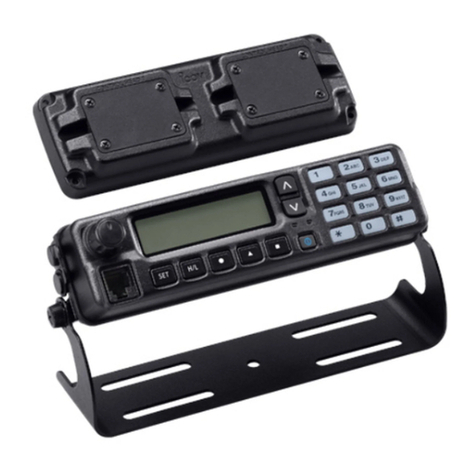
Icom
Icom RMK-4 User manual
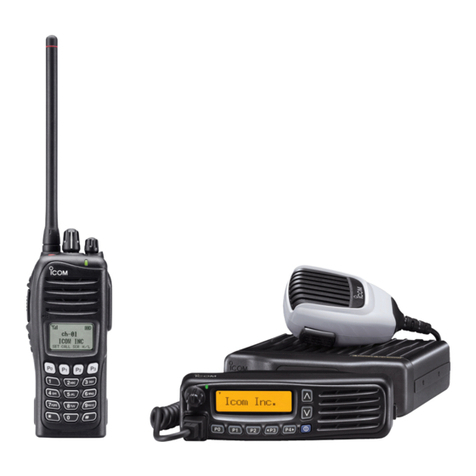
Icom
Icom F3161 Series Operating instructions
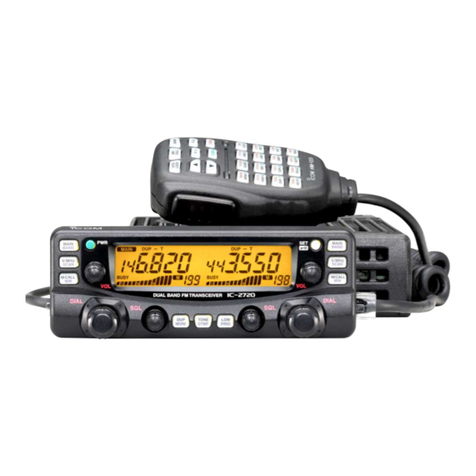
Icom
Icom IC-2720H User manual
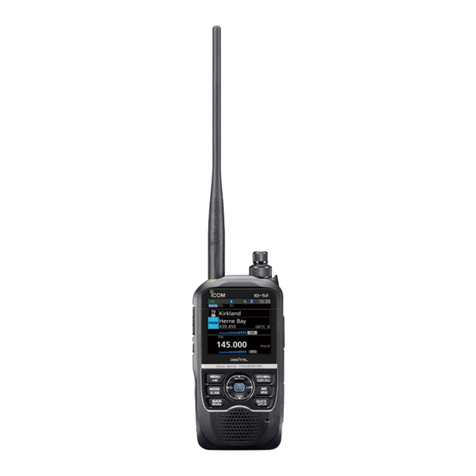
Icom
Icom ID-52A User manual
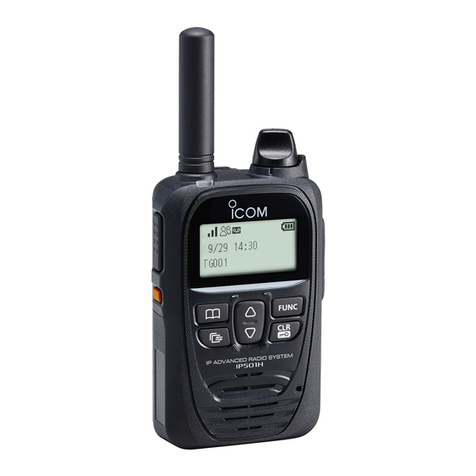
Icom
Icom IP501H User manual
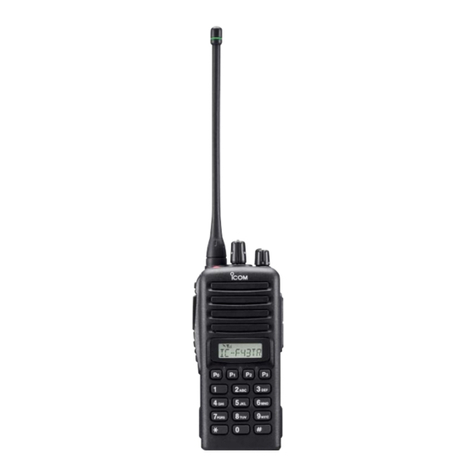
Icom
Icom IC-F43TR User manual
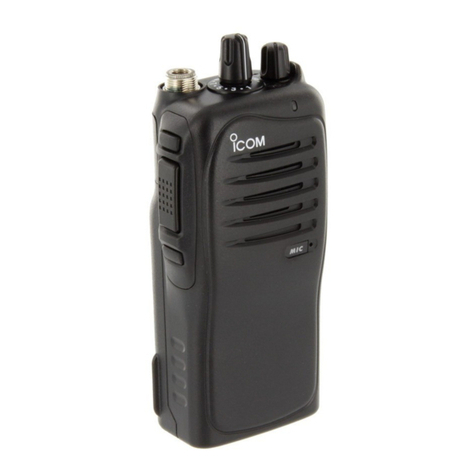
Icom
Icom Two-Way Radios Instruction Manual

Icom
Icom IC-V80 Operating instructions

Icom
Icom MOBILE RADIO User manual
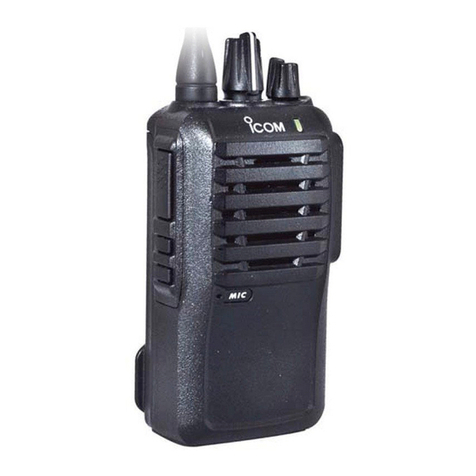
Icom
Icom IC-F3001 Installation and operating instructions

Icom
Icom IC-F43TR User manual
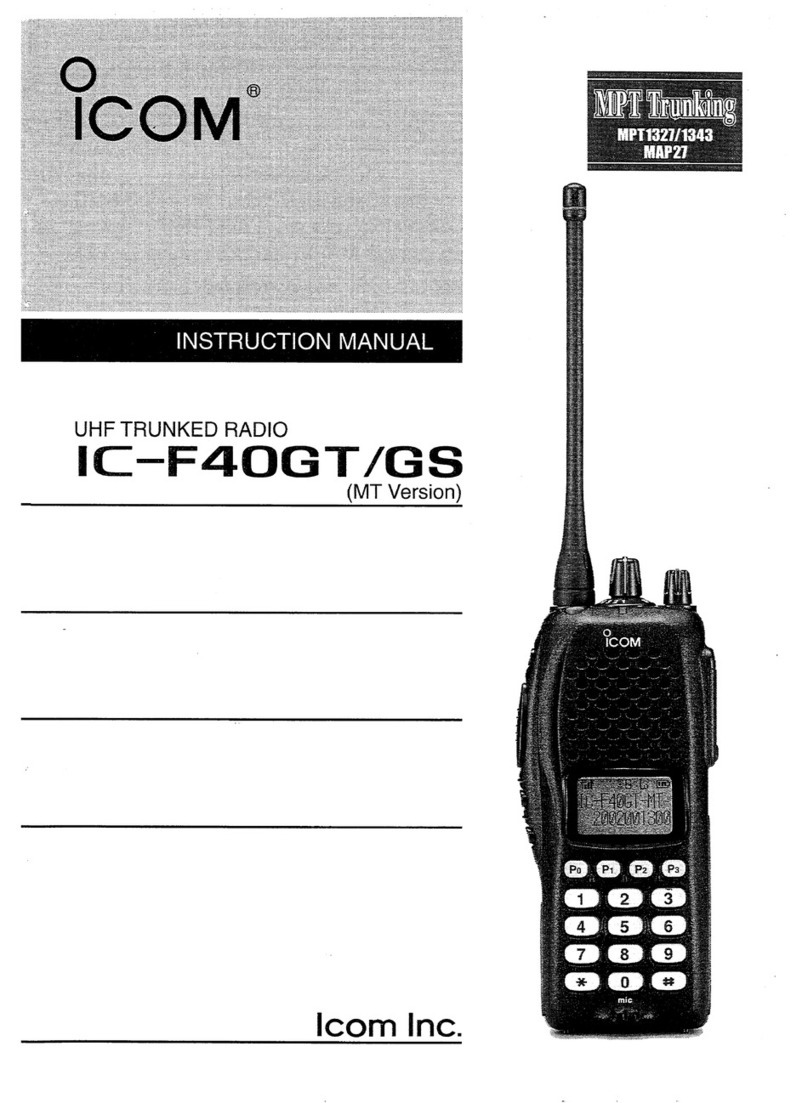
Icom
Icom IC-F40GT User manual

Icom
Icom IC-2A User manual

Icom
Icom IC-2720H Operating instructions

Icom
Icom IC-2720 Product information sheet

Icom
Icom IC-F1010 User manual

Icom
Icom IC-SAT100M User manual
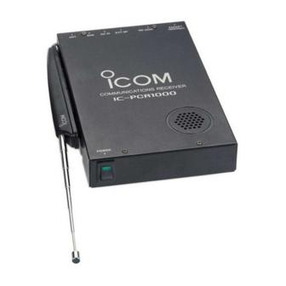
Icom
Icom IC-PCR1000 User manual
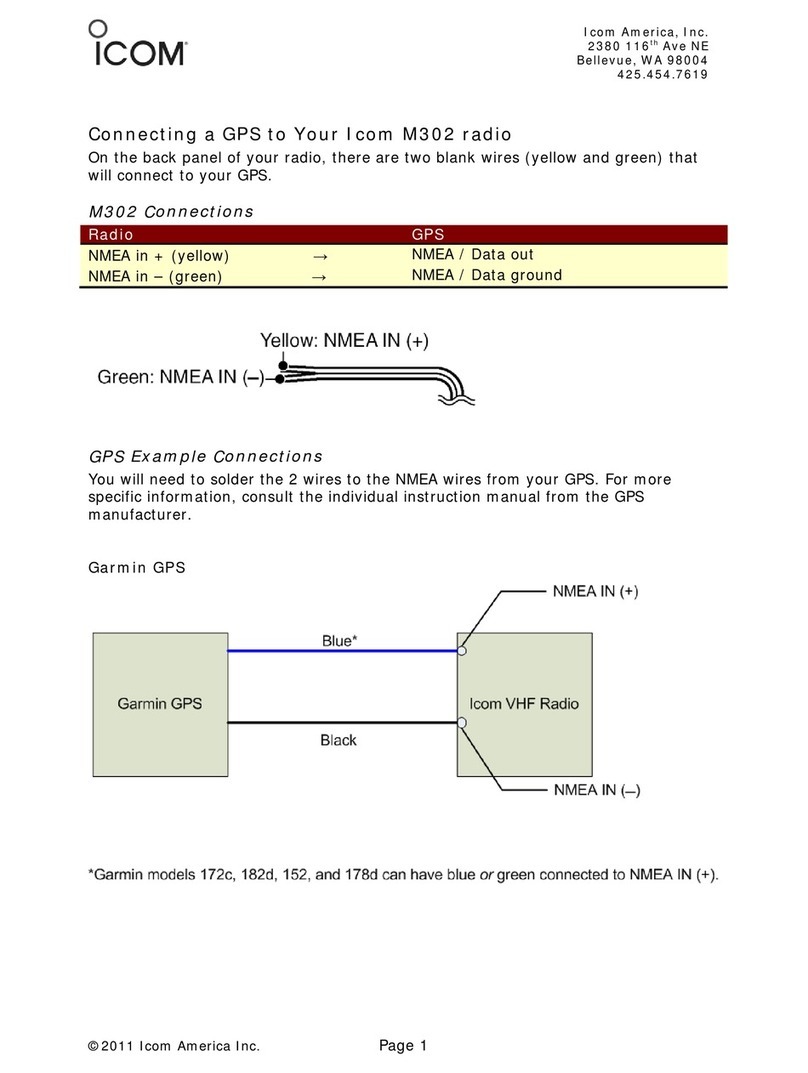
Icom
Icom M302 Instruction manual
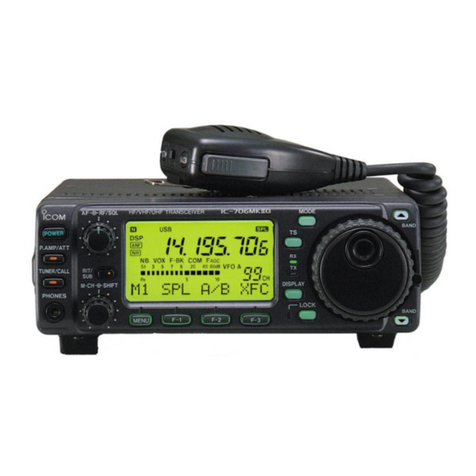
Icom
Icom IC-706MKIIG User manual

